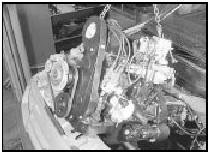Engine/manual gearbox assembly - removal and separation
Note: Refer to the warning in Section 8 before proceeding. A suitable hoist and lifting tackle will be required for this operation.
Removal
1 Proceed as described in Section 9,
paragraphs 1 to 17 inclusive.
2 Note the location of the earth strap on the rear inlet manifold stud, then remove the nut and disconnect the strap.
3 Working inside the vehicle, unscrew the gear lever knob and remove the centre console. Where a full length console is fitted, it is only necessary to remove the front tray.
4 Detach the outer gaiter from the retaining frame and withdraw it over the gear lever.
5 Unscrew the securing screws on early models, or release the clips on later models, and remove the gaiter retaining frame and inner gaiter.
6 Using a suitable Torx key, remove the screws securing the gear lever to the gearbox extension housing, and withdraw the gear lever. Note how the base of the gear lever locates over the selector shaft.
7 Jack up the vehicle and support on axle stands (see “Jacking and Vehicle Support”).
Ensure that there is sufficient working room beneath the vehicle.
8 To improve access, disconnect the exhaust downpipe from the manifold and remove the exhaust system.
9 Remove the propeller shaft.
10 Where applicable bend back the locktabs, then unscrew the two bolts in each case securing the two anti-roll bar U-clamps to the vehicle underbody. Lower the anti-roll bar as far as possible.
11 Proceed as described in Section 9, paragraphs 27 and 28.
12 Drain the engine oil into a container.
13 Unscrew the nuts or bolts, as applicable, securing the engine mountings to the crossmember. Recover the washers.
14 Disconnect the wiring from the reversing lamp switch.
15 Remove the retaining circlip, and withdraw the speedometer cable from the gearbox extension housing.
16 Support the gearbox with a trolley jack, using a block of wood between the jack and the gearbox to spread the load.
17 Unscrew the four bolts securing the gearbox crossmember to the vehicle underbody. Unscrew the central bolt securing the crossmember to the gearbox and remove the crossmember. Note the position of the earth strap, where applicable. Recover the mounting cup and where applicable the exhaust mounting bracket and heat shield.
18 Make a final check to ensure that all relevant wires, pipes and hoses have been disconnected to facilitate removal of the engine/ gearbox assembly.
19 Attach a suitable hoist to the engine lifting brackets located at the front and rear of the cylinder head. Arrange the lifting tackle so that the engine/gearbox assembly will assume a steep angle of approximately 40º to 45º as it is being removed.
20 Raise the engine/gearbox so that the engine mountings are clear of the crossmember, then ease the assembly forwards, at the same time lowering the trolley jack which is supporting the gearbox. Lift the assembly from the vehicle, taking care not to damage surrounding components (see illustration).

11.20 Lifting the engine/gearbox assembly from the vehicle
21 With the engine/gearbox assembly removed, temporarily reconnect the anti-roll bar to the underbody if the vehicle is to be moved.
Separation
22 To separate the engine from the gearbox,
proceed as follows.
23 Remove the starter motor.
24 Support the engine and gearbox horizontally on blocks of wood.
25 Unscrew the two securing bolts and disconnect the engine-to-gearbox brace from the engine and gearbox.
26 Unscrew and remove the engine-togearbox bolts, noting the location of the earth strap, and remove the bolt from the engine adapter plate.
27 Pull the engine and gearbox apart, taking care not to strain the gearbox input shaft. It may be necessary to rock the units slightly to separate them.
See also:
Engine valve clearance check (Every 12 000 miles (20 000 km) or 12 months)
SOHC engines
1 The valve clearances must be checked with
the engine cold. On carburettor models
remove the air cleaner.
2 Disconnect the HT leads from the spark
plugs and release them from the cl ...
Maintenance - bodywork, underside and fittings
The general condition of a vehicle’s
bodywork is the one thing that significantly
affects its value. Maintenance is easy but
needs to be regular. Neglect, particularly after
minor damage, can lead ...
Rear drum brake shoes - inspection and renewal
Caution: Refer to the
precautions in Section 1
1 The shoe friction material can be inspected
for wear without removing the roadwheels.
Working beneath the vehicle, prise the plug
from the brake b ...
